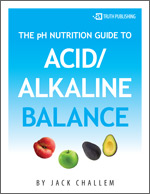
Table of Contents:
1. Introduction
2. The basic chemistry of pH balance
3. The four cases of dietary acidosis
4. pH, acidosis and osteoporosis
5. What should you eat for proper pH levels?
6. The pH of common substances
7. Scientific Citations
View more Special Reports by Mike Adams, the Health Ranger:
Nutrition Can Save America! This
eye-opening report explains how and why America can be saved from collapse by
unleashing the healing power of nutrition.
The Five Best Anti-Viral Products to Beat Influenza, Swine Flu, Bird Flu and SARS:
The best free report you'll find on the 'net, complete with trusted, independent
anti-viral product recommendations.
How to Build Your Financial Safety Net:
12 Ways to Achieve Prosperity During (and After) the Global Financial crisis
The 7 Principles of Mindful Wealth teaches
you how to break through wealth attraction limitations and embrace the level
of abundant financial wealth you truly deserve.
Breast Cancer Deception reveals
the shocking truth about the breast cancer industry's scheme to profit from disease
and censor natural cures.
Exclusive interview with Jay Robb covers
the philosophy and innovative products of this health & fitness champion.
The Amazon Herb Company: An Independent Review brings
you the latest news about the fast-growing Amazon Herb Company and its remarkable
success in healing people and the planet at the same time.
The pH Nutrition Guide to Acid / Alkaline Balance by
Jack Challem. Reveals secrets to "alkalizing" your body chemistry to prevent
disease and accelerate healing.
Pet Food Ingredients Revealed! Learn
the shocking truth about all 570 ingredients commonly used in pet food today.
(Warning: This report tells the truth that pet food manufacturers absolutely
do not want consumers to know...)
Medicine From Fish:
How to heal degenerative disease with a unique medicinal protein.
The Healing Power of Water:
The missing "dehydration link" to chronic disease (and how to reverse it with
water!) |

 Email this article to a friend Email this article to a friend  FREE Email Newsletter FREE Email Newsletter
The basic chemistry of pH balance
Back in high school chemistry, we learned about pH: acids had low numbers, alkalines had high numbers, and a pH of 7.0 was neutral. And it all meant absolutely nothing in terms of day-to-day life.
It now turns out that we have a better shot at long-term health if our body's pH is neutral or slightly alkaline. When we tilt toward greater acidity, which can be measured easily, we have a greater risk of developing osteoporosis, weak muscles, heart disease, diabetes, kidney disease, and a host of other health problems.
The solution, according to scientists who have researched "chronic low-grade metabolic acidosis," is eating a diet that yields more alkaline and less acid. Just what kind of diet is that? One that's high in fruits and vegetables. That might not seem like a big surprise, except for a few unexpected twists and turns.
Acid-yielding foods deplete mineralsIf the idea of balancing acid and alkaline foods seems a bit off the wall, it does have a somewhat checkered past. Most people, including physicians, aren't familiar with the dangers of acidosis, except in the most extreme situations. Those include lactic acidosis, from overexercise; ketoacidosis, when diabetes start burning their own fat; and renal acidosis, which can be a sign of kidney failure.
The original scientific research on acid-yielding and alkaline-yielding foods dates back to 1914 and was remarkably accurate, according to Loren Cordain, Ph.D., a professor and researcher in the department of health and exercise science at Colorado State University, Fort Collins. Then, in the 1930s and 1940s, the acid-alkaline concept was hijacked by early health food "nuts." Among them, William Hay, M.D., proposed an almost ritualistic eating habit based on food acidity or alkalinity. Since then, most doctors have viewed any discussion of acid and alkaline diets with a skeptical eye.
But the problem with acid-producing eating habits is very real, contends Cordain, a leading expert on the Paleolithic, or Stone Age diet. "After digestion, all foods report to the kidneys as being either acidic or alkaline," he says. "The kidneys are responsible for fluid balance and maintaining a relatively neutral pH in the body."
That's where things get interesting. When acid-yielding foods lower the body's pH, the kidneys coordinate efforts to buffer that acidity. Bones release calcium and magnesium to reestablish alkalinity, and muscles are broken down to produce ammonia, which is strongly alkaline. By the time the response is all over, your bone minerals and broken down muscle get excreted in urine.
Long term, excess acidity leads to thinner bones and lower muscle mass, points out Anthony Sebastian, M.D., of the University of California, San Francisco. These problems are compounded by normal aging, which increases acidosis, bone loss, and muscle wasting. Along the way, calcium and magnesium losses can equate to deficiencies, with many ramifications. Both minerals play essential roles in bone formation and normal heart rhythm. Low magnesium levels can cause muscle cramps, arrhythmias, and anxiety.

 Want
more special reports like this e-mailed to you when they're available? Click here for free e-mail alerts. Want
more special reports like this e-mailed to you when they're available? Click here for free e-mail alerts.
Share this Special Report by linking to it
Copy and paste the following HTML code into any web page:
 Get articles like this delivered to you FREE in our popular email newsletter Get articles like this delivered to you FREE in our popular email newsletter |
Advertise with NaturalNews...
Support NaturalNews Sponsors:
Advertise with NaturalNews...
|

